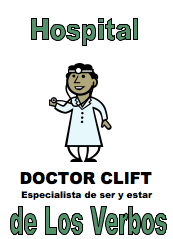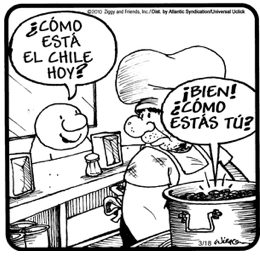One of my favorite grammar points to teach is the difference between the verbs SER y ESTAR. While both verbs mean “to be” in English, in Spanish they couldn’t be more different. I know many teachers use an acronym to teach this sometimes difficult topic.
Ser:
DOCTOR (Description, Origin, Characteristic, Time/date, Occupation, Relationship)
DON’T (Description, Origin, Nationality, Time)
JETCO (Jobs, Events, Time, Characteristics, Origin)
Estar:
CLIFT (Condition, Location, -Ing verb, Feeling, Taste)
PLACE (Position, Location, Action, Condition, Emotion)
ELF (Emotion, Location, Feeling)
HELP (Health, Emotion, Location, Present Progressive)
My favorite is DOCTOR and CLIFT because I use the idea to create a character of someone  who is an “especialista de ser y estar”. I totally play this up, telling my students that they will have a guest speaker as a substitute and that I will not be in class because I have “meetings”. On that day when they see that the “guest” looks a lot like their regular Spanish teacher wearing a lab coat and wearing a guest ID badge, they start to think I’m a bit crazy. But I’m ok with that.
who is an “especialista de ser y estar”. I totally play this up, telling my students that they will have a guest speaker as a substitute and that I will not be in class because I have “meetings”. On that day when they see that the “guest” looks a lot like their regular Spanish teacher wearing a lab coat and wearing a guest ID badge, they start to think I’m a bit crazy. But I’m ok with that.
They soon realize that the “Doctor” doesn’t speak any English at all and responds best when spoken to in Spanish. Although, he does rely on the students to help translate certain things to clarify for struggling students.
For a copy of this particular lesson, a 19 page document, including an ID badge, guided notes packet, over four pages of worksheets, and a quiz, click here.
For more Ser and Estar resources, including Ziggy Comics….
Be sure to read our previous post with 3 other great resources for ser and estar.
I have also found Ziggy en español comics to include some real great examples of using ser and estar.

- This comic worked better in English when the verb was the same.
In the above comic, your students can explain that “está” is used because of the location, but then it changes to “es” because it is now starting description/characteristics.
And the comic below is a play on the difference between a TASTE and FEELING.

How is the chili today (taste)? I'm fine, thanks (feeling)
And, of course, on the day of the quiz you can post this comic on the Spanish Inquisition:

For Ser Estar bookmarks/reference sheets, please visit our Teaching Supplies store.











I use DIPNDOTCOM – description, identification, possession, nationality, date, occupation, time, characteristic, origin, material. 🙂
I teach college students and I use DONT PP in HEL — Description origin nationality time possesion profession, then Health emotion location. I made handouts of a little devil peeing with a red ex through it. I suppose it works because they are all 18+ and think it’s funny, may not work at the high school level